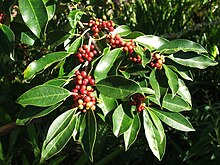Ilex mitis
| Ilex mitis | |
|---|---|

| |
| Scientific classification | |
| Kingdom: | Plantae |
| Clade: | Tracheophytes |
| Clade: | Angiosperms |
| Clade: | Eudicots |
| Clade: | Asterids |
| Order: | Aquifoliales |
| Family: | Aquifoliaceae |
| Genus: | Ilex |
| Species: | I. mitis
|
| Binomial name | |
| Ilex mitis (L.) Radlk.
| |
Ilex mitis (commonly called Cape holly, African holly, waterboom or umDuma) is a tall, dense, evergreen tree that is indigenous to Southern Africa. It makes an excellent fast-growing hedge for gardens - growing tall, straight and dense. [2]
Appearance[]

If not pruned, Ilex mitis can grow to a height of 20 meters or more. Its trunk is straight, grey or brown and usually spotted while it produces a dense, even canopy. Young growth and leaf-stalks tend to be purple or red. The simply shaped, pointed, shiny-green leaves have wavy margins that are sometimes slightly serrated. The tree can be identified by its purple or maroon leaf stalks and the leaves’ strongly impressed midribs.
The small, white, scented flowers appear in spring. Ilex mitis is dioecious, with separate male and female trees.
The bright red fruits ripen in autumn, creating a colourful display and attracting a variety of birds.
Distribution[]
This is the only holly (Ilex) species from South Africa, where it grows naturally in all provinces, from Cape Town in the south, all the way up past Zimbabwe and Malawi in the north. It is usually found growing on the banks of rivers and in moist spots in Afro-montane forest.
Growing Ilex mitis[]
This is a fast-growing tree, growing nearly a meter a year in ideal conditions. It grows especially well in wet areas like beside lakes or rivers and it tolerates frost, making it suitable for colder climates. Fresh seed will usually germinate, but should first be dried out a bit. If kept moist after planting, the young plants usually sprout several weeks later. It transplants well, but needs to be protected from drying out and direct sun whilst young.
It has no known diseases or pests, though in the wild it is one of the favourite foods of elephants.
Pictures[]
A small Ilex mitis, growing un-pruned as a feature tree.
Foliage detail

Ilex mitis blossoms.
References[]
- ^ Barstow, M. (2018). Ilex mitis. The IUCN Red List of Threatened Species 2018: e.T62381A3114683. Downloaded on 14 August 2018.
- ^ http://www.plantzafrica.com/planthij/ilexmitis.htm
| Wikimedia Commons has media related to Ilex mitis. |
External links[]
- Ilex mitis at PlantZAfrica.com
- Dressler, S.; Schmidt, M. & Zizka, G. (2014). "Ilex mitis". African plants – a Photo Guide. Frankfurt/Main: Forschungsinstitut Senckenberg.
- IUCN Red List least concern species
- Ilex
- Trees of Africa
- Flora of South Tropical Africa
- Flora of South Africa
- Trees of South Africa
- Afromontane flora
- Garden plants of Africa
- Plants used in bonsai
- Ornamental trees



